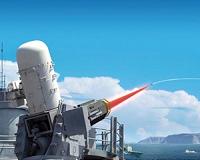| . |  |
. |
Port Hueneme CA (SPX) Jul 27, 2010 Northrop Grumman recently completed a series of tests of the Maritime Laser Demonstration (MLD) system, moving high-energy lasers a step closer to deployment aboard U.S. Navy ships. Recent shore-based tests at the Naval Surface Warfare Center (NSWC) in Port Hueneme proved the MLD system's ability to track small boats at long ranges and in a marine environment. "Tracking tests were part of a larger program designed to demonstrate laser weapon system capability for fleet defense," according to Steve Hixson, vice president of Space and Directed Energy Systems for Northrop Grumman Aerospace Systems. "Such lasers would complement other defensive systems to address certain threats more effectively and at lower cost than traditional weapons." Managed by the Office of Naval Research (ONR), the MLD program has a goal of demonstrating how high-energy laser weapons can be adapted for naval operations, specifically to engage targets such as swarms of enemy fast patrol boats. "The program places a high value on experiences gained through technologies recently matured through other Defense Department development efforts," said Dan Wildt, vice president of Directed Energy Systems for Northrop Grumman Aerospace Systems. "For MLD, lessons learned were taken from the success of the Northrop Grumman-developed Joint High Power Solid State Laser, a compact, high-brightness laser. We also applied precision tracking experience gained from the Tactical High Energy Laser test bed at White Sands Missile Range, N.M., which has destroyed 46 rockets, artillery and mortar rounds in flight." The Port Hueneme tests, conducted by ONR, demonstrated the ability of a Northrop Grumman laser system to acquire and track the threat representative small boats, he noted. "This and previous tests are critical steps leading to the first-ever demonstration of a laser weapon at-sea. The bar for performance and safety is very high for a system that will be going onto a ship. Our approach has been to carefully plan, test and verify the system at every step, which separates MLD from just another technology demonstration. MLD will give the Navy the fundamental data that is needed to decide whether to go forward and deploy this capability in the near term," according to Wildt. Last fall, Northrop Grumman tested the MLD system at the company's San Juan Capistrano, Calif., test site. In these tests, a high-energy laser was generated through the system to a target board. Atmospheric and system models were used to demonstrate the ability to transport, rapidly setup and operate the system.
Share This Article With Planet Earth
Related Links Northrop Grumman Learn about laser weapon technology at SpaceWar.com
 Phalanx Sensors Used In Laser Shoot Down Of Airborne Targets
Phalanx Sensors Used In Laser Shoot Down Of Airborne TargetsFarnborough, UK (SPX) Jul 20, 2010 Raytheon and a U.S. Navy team used a combined-beam fiber laser to shoot down four unmanned aerial vehicles in flight during an over-the-water engagement. The UAV targets were engaged and destroyed using the Navy's Laser Weapon System guided by Raytheon's Phalanx Close-in Weapon System sensor suite. LaWS is made up of six industrial-use lasers that simultaneously focus on the target. ... read more |
|
| The content herein, unless otherwise known to be public domain, are Copyright 1995-2010 - SpaceDaily. AFP and UPI Wire Stories are copyright Agence France-Presse and United Press International. ESA Portal Reports are copyright European Space Agency. All NASA sourced material is public domain. Additional copyrights may apply in whole or part to other bona fide parties. Advertising does not imply endorsement,agreement or approval of any opinions, statements or information provided by SpaceDaily on any Web page published or hosted by SpaceDaily. Privacy Statement |